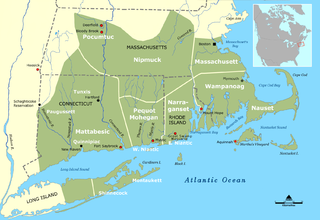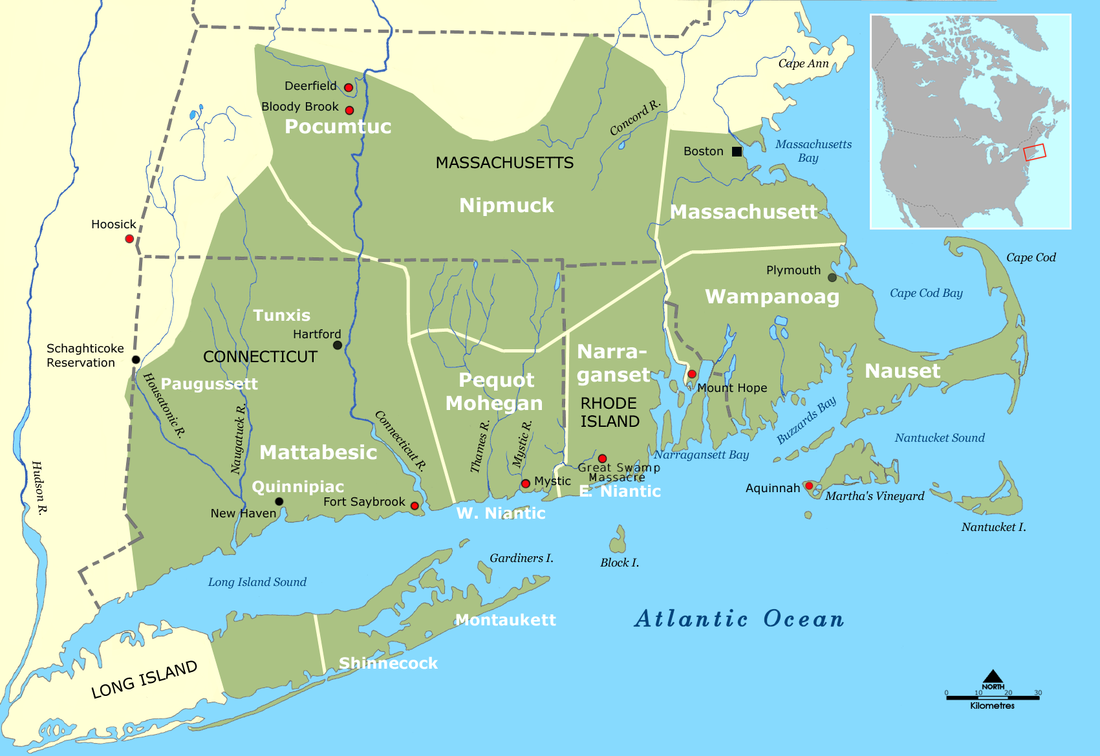Quiripi (pronounced /ˈkwɪrɪpiː/ KWIH-rih-pee,[1] also known as Mattabesic,[2] Quiripi-Unquachog, Quiripi-Naugatuck, and Wampano) was an Algonquian language formerly spoken by the indigenous people of southwestern Connecticut and central Long Island,[3][4] including the Quinnipiac, Unquachog, Mattabessett (Wangunk), Podunk, Tunxis, and Paugussett (subgroups Naugatuck, Potatuck, Weantinock). It has been effectively extinct since the end of the 19th century,[5] although Frank T. Siebert, Jr., was able to record a few Unquachog words from an elderly woman in 1932.[6]
Affiliation and dialects
Quiripi is considered to have been a member of the Eastern Algonquian branch of the Algonquian language family.[7][8] It shared a number of linguistic features with the other Algonquian languages of southern New England, such as Massachusett and Mohegan-Pequot, including the shifting of Proto-Eastern Algonquian */aː/ and */eː/ to /ãː/ and /aː/, respectively, and the palatalization of earlier */k/ before certain front vowels.[9][10] There appear to have been two major dialects of Quiripi: an "insular" dialect spoken on Long Island by the Unquachog and a "mainland" dialect spoken by the other groups in Connecticut, principally the Quinnipiac.[11][12]
Attestation
Quiripi is very poorly attested,[13] though some sources do exist. One of the earliest Quiripi vocabularies was a 67-page bilingual catechism compiled in 1658 by Abraham Pierson, the elder, during his ministry at Branford, Connecticut,[3][14] which remains the chief source of modern conclusions about Quiripi.[4] Unfortunately, the catechism was "poorly translated" by Pierson,[4] containing an "unidiomatic, non-Algonquian sentence structure."[15] It also displays signs of dialect mixture.[16] Other sources of information on the language include a vocabulary collected by the Rev. Ezra Stiles in the late 1700s[17] and a 202-word Unquachog vocabulary recorded by Thomas Jefferson in 1791,[6] though the Jefferson vocabulary also shows clear signs of dialect mixture and "external influences."[18] Additionally, three early hymns written circa 1740 at the Moravian Shekomeko mission near Kent, Connecticut, have been translated by Carl Masthay.[19]
Phonology
Linguist Blair Rudes attempted to reconstitute the phonology of Quiripi, using the extant documentation, comparison with related Algonquian languages, as "reconstructing forward" from Proto-Algonquian.[20] In Rudes' analysis, Quiripi contained the following consonant phonemes:[21]
| ^ /ʃ/ was a distinct phoneme only in the mainland dialect; in Unquachog it had merged with /s/ |
Quiripi's vowel system as reconstituted by Rudes was similar to that of the other Southern New England Algonquian languages. It consisted of two short vowels /a/ and /ə/, and four long vowels /aː/, /iː/, /uː/, and /ʌ̃/.[21]
Orthography
- a – [ʌ]
- â – [aː]
- ch – [t͡ʃ]
- h – [h]
- i – [iː]
- k – [k]
- m – [m]
- n – [n]
- o – [uː]
- ô – [ʌ̃]
- p – [p]
- r – [r]
- s – [s]
- sh – [ʃ]
- t – [t]
- u – [ə]
- w – [w]
- y – [j][22]
References
Bibliography
External links
Wikiwand in your browser!
Seamless Wikipedia browsing. On steroids.
Every time you click a link to Wikipedia, Wiktionary or Wikiquote in your browser's search results, it will show the modern Wikiwand interface.
Wikiwand extension is a five stars, simple, with minimum permission required to keep your browsing private, safe and transparent.

